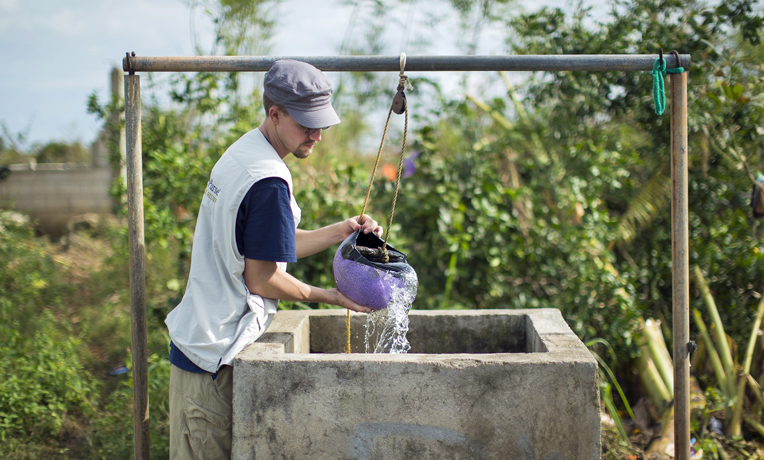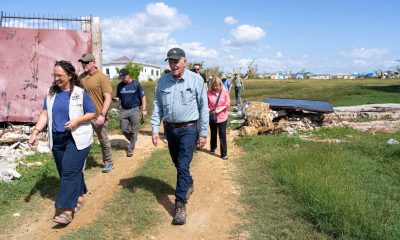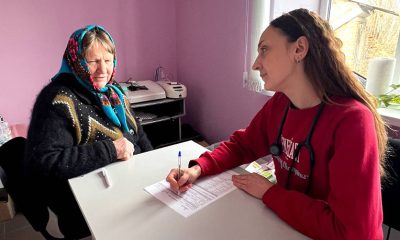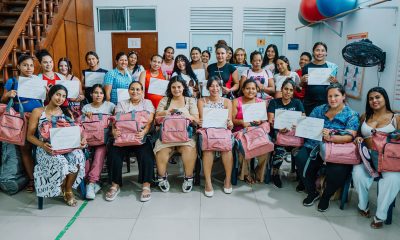In the days immediately following Typhoon Haiyan, the Samaritan’s Purse disaster response team saw devastating destruction and incredible resilience. One team member reflects on his time spent on Bantayan Island.
Andrew Conard works with Samaritan’s Purse in Cambodia as a water, sanitation, and hygiene program manager. When Typhoon Haiyan hit the Philippines, Andrew joined our team to provide clean water to storm victims.
The word “bangon” means rise up in the Visayan language. The Visayas are a region in the Philippines that were devastated by the recent typhoon. I just returned from the area after spending 10 long days working with Samaritan’s Purse on the disaster response team.
On November 8, my wife, Whitney, and I were in Phnom Penh, Cambodia, when I found out that I was officially given a spot on the team. My plane ticket was booked for the following morning. As I packed my bags, I started thinking through different scenarios. It’s always hard to know the exact situation that you’ll find entering into an area right after a disaster.

Andrew assessed the needs of people in the community by meeting with them.
My role as water, sanitation, and hygiene specialist meant I needed to know how to get people clean water as quickly as possible. I’ve been working with water programs in Cambodia for more than two years, but this was different than anything I’d done before.
In Cambodia, we mainly work with household water treatment and small-scale water systems in rural areas. However, the typhoon left a path of destruction throughout cities. I started thinking about the larger community-sized water treatment options available. Samaritan’s Purse had used these systems in places like Haiti after the 2010 earthquake, but I still had not seen one in real life. So, I started reading through the instruction manuals and reviewing all of the technical information I could get my hands on.
The following morning I left to go to the airport with my boss. We were the first ones from Samaritan’s Purse to land in the Philippines.
The next day, we went to a meeting at the United Nations office. There were more than 50 other organizations represented. We didn’t yet know the level of destruction that existed, but we all knew that it was enormous.
Our team set up a base office in Cebu City. I was originally supposed to fly to Tacloban City, but that flight was canceled because they were only allowing military flights at the time. I was a little disappointed that I couldn’t get there because I had heard there was a lot of need, but I was also relieved because of all the reports of violence and looting.

Getting from one place to another in the Philippines has sometimes been difficult, especially with debris covering roads. Our staff came up with creative ways to get to the people we were helping.
So instead of flying to Tacloban, we drove up north to a city called Bogo. We could see many houses were damaged in Bogo, and many people who lost their homes were living in evacuation centers or crammed into remaining family members’ homes.
Although we were only planning to do an assessment that day, we felt so bad for these people and their needs that we stayed late and went to a nearby store to purchase plastic tarps for them to use as temporary shelter.
That day there was some fear that another typhoon was going to hit. Fortunately, the next storm that was picked up on the radar didn’t come directly into our path and ended up only leaving a small amount of rain.
Distributing to People in Need
The next day, we prepared for our first distribution to people on Bantayan Island. This area had been directly hit by the typhoon and was devastated. Many of the people on this island were fisherman, and all their boats had been destroyed. They had few resources left.
As I went around the island doing my initial assessment, I found the people were able to find water in wells that were on the island. I encouraged them to boil the water before drinking to avoid diseases.

Despite the overwhelming needs in the Philippines, many people who were left with nothing still had smiles on their faces.
We started the distribution by providing food and hygiene kits to an initial 3,000 families. We distributed the relief kits through local churches so that they would be able to participate in the work as much as possible. While in the churches, I saw thousands of people who were thankful for the donations.
I was happy to see people get some help but sad to see others who were still left waiting. Later that week we started to prepare for our next distribution. We also started to see more organizations coming to provide relief.
A few days later, I went to some smaller islands a few hours from Bantayan Island. One was called Kinatarken Island. I was amazed to see more than 8,000 people living there. They were struggling to get enough water because their power lines were all down and they didn’t yet have a generator to run the one well pump that served 4,000 people.

People need drinking water to live, but it’s also a necessity for cooking and bathing.
It was difficult getting to the island because there were only small motorboats that went back-and-forth every day. The journey to the island took about two hours, which is a significant amount of time when you are trying to reach multiple places as quickly as possible.
I started working on a plan for how to help them but realized I was getting sick. I had started to develop a severe rash all over my legs and one of my arms, and it was becoming so itchy that I had to find a doctor. I ended up heading back to Cebu City so I could go to the hospital and get some medicine.
The day before I left, Samaritan’s Purse sent a team to Tacloban. Most of the injuries and deaths from the storm occurred there. I’m praying for their wounds to heal through medicine and the love of God and for all those who lost their homes and are struggling to rebuild their lives.






